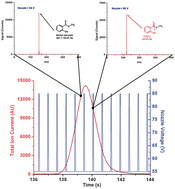The recent development of ambient desorption/ionization mass spectrometry (ADI-MS) has enabled fast, simple analysis of many different sample types. The ADI-MS sources have numerous advantages, including little or no required sample pre-treatment, simple mass spectra, and direct analysis of solids and liquids. However, problems of competitive ionization and limited fragmentation require sample-constituent separation, high mass accuracy, and/or tandem mass spectrometry (MS/MS) to detect, identify, and quantify unknown analytes. To maintain the inherent high throughput of ADI-MS, it is essential for the ion source/mass analyzer combination to measure fast transient signals and provide structural information. In the current study, the flowing atmospheric-pressure afterglow (FAPA) ionization source is coupled with a time-of-flight mass spectrometer (TOF-MS) to analyze fast transient signals (<500 ms FWHM). It was found that gas chromatography (GC) coupled with the FAPA source resulted in a reproducible (<5% RSD) and sensitive (detection limits of <6 fmol for a mixture of herbicides) system with analysis times of ca. 5 min. Introducing analytes to the FAPA in a transient was also shown to significantly reduce matrix effects caused by competitive ionization by minimizing the number and amount of constituents introduced into the ionization source. Additionally, MS/MS with FAPA-TOF-MS, enabling analyte identification, was performed via first-stage collision-induced dissociation (CID). Lastly, molecular and structural information was obtained across a fast transient peak by modulating the conditions that caused the first-stage CID.

You have access to this article
 Please wait while we load your content...
Something went wrong. Try again?
Please wait while we load your content...
Something went wrong. Try again?


 Please wait while we load your content...
Please wait while we load your content...